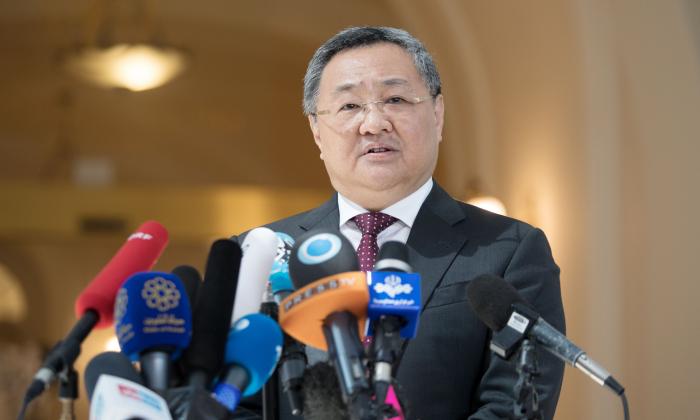China, France, the UK, the United States, and Russia issued a
joint statement on Jan. 3, affirming that
nuclear war and the proliferation of nuclear weapons ought to be avoided at all costs.
“We affirm that a nuclear war cannot be won and must never be fought,” the statement said.
“As nuclear use would have far-reaching consequences, we also affirm that nuclear weapons—for as long as they continue to exist—should serve defensive purposes, deter aggression, and prevent war. We believe strongly that the further spread of such weapons must be prevented.”
The five nations, which make up the permanent members of the
United Nations Security Council, are all nuclear powers. Nevertheless, they pledged that “the ultimate goal of a world without nuclear weapons with undiminished security for all,” was their ultimate aim.
A mere hours later, however, a Chinese official vowed that the country’s
communist regime would continue its unprecedented efforts to modernize its nuclear arsenal.
“
China will continue to modernize its nuclear arsenal for reliability and safety issues,”
said Fu Cong, director-general of the Foreign Ministry’s arms control department.
Fu dismissed evidence that the Chinese regime was expanding its nuclear arsenal while maintaining that the country would not consider any suggested decreases to its nuclear stockpiles until the United States and Russia drastically reduced their own.
“The two superpowers need to … drastically reduce their nuclear capabilities to a level comparable to the level of China, and for that matter to the level of France and the UK, so that other nuclear states can join in this process,” Fu
said at a Tuesday briefing.
Fu’s remarks contradict a growing
body of evidence that the Chinese regime is rapidly expanding its nuclear arsenal to compete with Russia and the United States, which are the world’s largest nuclear powers.
A November
report by the Pentagon found that the Chinese regime would likely have 1,000 nuclear missiles by 2030. The report noted the proliferation of nuclear missile silos and increased production of nuclear energy byproducts in China as contributing factors to the rapidity of the expansion.
The United States and Russia are
believed to house 5,500 and 6,255 nuclear warheads respectively, though both nations are bound by the Strategic Arms Reduction Treaty (
START) to never maintain more than 1,550 active nuclear missiles at a time.
The
expansion and modernization program is part of a larger push by the Chinese Communist Party (
CCP) to
leapfrog U.S. military development by effectively winning the race toward next-generation technologies without wasting resources on matching current American capabilities.
The program has propelled Sino-American relations to a new low.
A prime example of this effort is the CCP’s
test of a nuclear-capable
hypersonic weapon in July, which appeared similar to technology that the United States tested a decade ago but ultimately
scrapped. It was later discovered that the weapon launched a
second missile while in hypersonic flight, sparking fears that the regime was abandoning its alleged no-first use nuclear policy—a stance which provides that nuclear weapons only be used in defense against a nuclear first strike.
Then-Vice Chairman of the Joint Chiefs of Staff, John Hyten,
said that the system could feasibly be used to launch a surprise nuclear strike against the United States, apparently disproving Chinese leadership’s insistence that it has a no first-use policy for nuclear weapons.
“They look like a first-use weapon,” said during an
interview with CBS. “That’s what those weapons look like to me.”
“They launched a long-range missile,” Hyten said. “It went around the world, dropped off a hypersonic glide vehicle that glided all the way back to China, that impacted a target in China.”
Likewise, the U.S.-China Economic and Security Review Commission, a congressionally-mandated advisory body, issued a
report in November that suggested the CCP could be deliberately moving away from a defensive-only nuclear policy.
That report cited the regime’s recent decision to implement a launch-on-warning posture for some of its nuclear forces. As the name suggests, such a posture means that a retaliatory nuclear strike would be launched upon receiving a mere warning that a nuclear attack was imminent, rather than waiting to verify that a detonation actually occurred.
Both the United States and Russia host launch-on-warning units. Experts have warned, however, that the CCP is in a
sprint to dominate new nuclear weapons technologies.
Experts and politicians alike have voiced
warnings that the regime is wholly uninterested in notions of parity, and have
expressed concern that the regime’s growing nuclear arsenal could give cover to conventional acts of war or otherwise be used to
coerce international rivals.
As such, the regime’s dedication to upholding the spirit of the joint statement has been
called into question by multiple experts.





